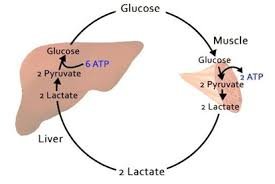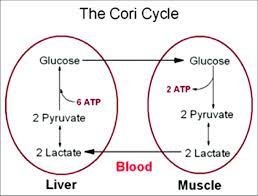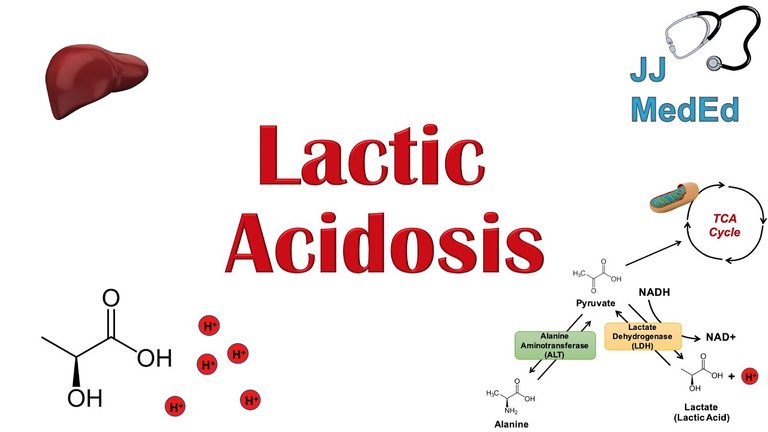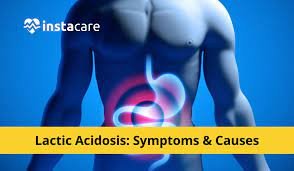This is the over production of lactate
arises in the skeletal muscle during strenuous exercise
under this condition, NADH production from glycolysis and TCA cycle reaction far exceeds the oxidative capacity of the Electron Transport Chain.
NADH/NAD+ ratio is high and favours lactate formation from pyruvate
Lactate accumulates in the muscle causing a drop in intracellular pH...It
Causes cramps/stiffness in the muscle (lactic acidosis).
There is increased blood lactate, and decreased bicarbonate and low pH
Causes
The most common cause of lactic acidosis is severe medical illness in which blood pressure is low and too little oxygen is reaching the body's tissues. Intense exercise or convulsions can cause temporary lactic acidosis. Certain diseases can also cause the condition, including:

Source
Alcoholism
Cancer
Cirrhosis
Cyanide poisoning
Kidney failure
Respiratory failure
Sepsis (severe infection)
Some medicines can rarely cause lactic acidosis:
Beta adrenergic agonist inhalers used to treat asthma or COPD (albuterol and salmeterol)
Epinephrine
Metformin, used to treat diabetes (most often when overdosed)
Propofol
SYMPTOMS MAY INCLUDE:
Nausea
Vomiting
Weakness
muscle pains or cramping
overall body discomfort
abdominal pain and discomfort
body weakness
fatigue, lethargy, and unusual sleepiness
reduced appetite problems
diarrhea
nausea and vomiting
headaches
THE MOST COMMON CAUSES OF LACTIC ACIDOSIS Are:
cardiogenic shock
hypovolemic shock
severe heart failure
sepsis
severe trauma
diabetes mellitus
extreme physical exercise
Lactic acidosis can occur in people whose kidneys are unable to get rid of excess acid.
CORI CYCLE HELPS TO COUNTERBALANCE AND HELP STOP LACTIC ACIDOSIS

Source
Muscular activity requires ATP, which is provided by the breakdown of glycogen in the skeletal muscles. The breakdown of glycogen, known as glycogenolysis, releases glucose in the form of glucose 1-phosphate (G1P). The G1P is converted to G6P by phosphoglucomutase. G6P is readily fed into glycolysis, (or can go into the pentose phosphate pathway if G6P concentration is high) a process that provides ATP to the muscle cells as an energy source. During muscular activity, the store of ATP needs to be constantly replenished. When the supply of oxygen is sufficient, this energy comes from feeding pyruvate, one product of glycolysis, into the citric acid cycle, which ultimately generates ATP through oxygen-dependent oxidative phosphorylation.
When oxygen supply is insufficient, typically during intense muscular activity, energy must be released through anaerobic metabolism. Lactic acid fermentation converts pyruvate to lactate by lactate dehydrogenase. Most importantly, fermentation regenerates NAD+, maintaining its concentration so additional glycolysis reactions can occur.
SIGNIFICANCE
The cycle's importance is based on preventing lactic acidosis during anaerobic conditions in the muscle. However, normally, before this happens, the lactic acid is moved out of the muscles and into the liver.
Additionally, this cycle is important in ATP production, an energy source, during muscle exertion. The end of muscle exertion allows the Cori cycle to function more effectively. This repays the oxygen debt so both the electron transport chain and citric acid cycle can produce energy at optimum effectiveness.
The Cori cycle is a much more important source of substrate for gluconeogenesis than food. The contribution of Cori cycle lactate to overall glucose production increases with fasting duration before plateauing. Specifically, after 12, 20, and 40 hours of fasting by human volunteers, gluconeogenesis accounts for 41%, 71%, and 92% of glucose production, but the contribution of Cori cycle lactate to gluconeogenesis is 18%, 35%, and 36%, respectively. The remaining glucose production comes from protein breakdown, muscle glycogen, and glycerol from lipolysis.
References:
https://medlineplus.gov/ency/article/000391.htm


